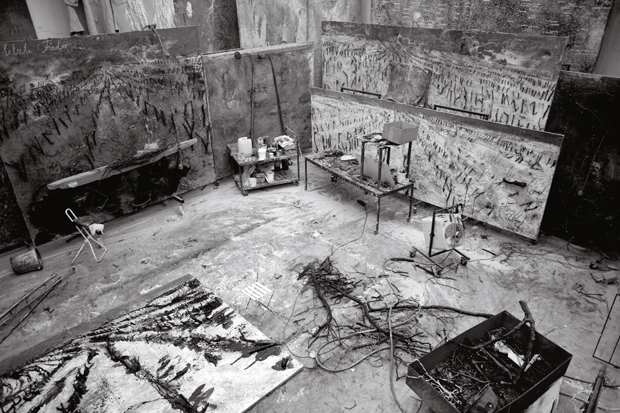
A look inside Anselm Kiefer's studio
Phaidon Focus book goes inside the celebrated German artist's sprawling studio complex La Ribaute in France
phaidon.com is currently spending its lunch breaks reading through the excellent Focus series of books that are published next month - today we finished the Anselm Kiefer one by Matthew Biro. First a little about the Focus series. The books are designed as a lively, authorititive and accessible introduction to the work of the artists featured in the (initial) six-strong series (Kim, the editor, is already hard at work on the next instalment). As the title suggests, each features special Focus sections that explore specific and important themes, series, pieces or events in each artist's career, so whether you're new to the artist or you already know a bit you'll come away enlightened and, we hope, nourished.
{media1}
With an artist like Kiefer you can imagine the focus points are many and varied. We don't have room here to bring you a precis of all of them - and naturally we want you to buy the books. However, we can say it was a tough choice picking just one particular 'Focus' to represent what is an engaging yet thorough book by the foremost Kiefer expert. In the end it was a choice between Biro's brilliantly enlightening deconstruction of Kiefer's 1981 work Interior,_ Innenraum and his description of La Ribaute - _the studio complex the artist began creating in the 1990s and what Biro calls 'a total work of art'. In the end, we plumped for the latter purely because it's better suited to a blog entry and because we suspected a few more of our readers might not now that much about it.
{media2}
"From the mid 1990s, Kiefer’s Barjac studio-estate, which spread over 35 hectares (86 acres), also became his most ambitious project, where he made, displayed, warehoused and imagined his oeuvre. A former silk factory on a hill that the German expatriate transformed into a vast complex of living spaces, studios, workshops and storage facilities, it was also an environment in which he created a new type of ‘land art’ consisting of gigantic concrete structures, some reduced to post-war-like ruins, in the midst of the rural French countryside. For some, La Ribaute was Kiefer’s ‘Gesamtkunstwerk’, or ‘total work of art’, a theatrical experience that combined multiple media and that stood as the pinnacle and sum-mation of his career.
As this studio complex developed over 17 years, it grew in shape and complexity. Originally consisting of three nineteenth-century stone buildings surrounded by fields and woods, it was expanded with a single-minded intensity to combine modern functional structures with strange, unwieldy, reinforced-concrete constructions. Since the late 1990s, more than fifty separate edifices – glass and steel greenhouses as well as concrete bunkers - were erected on the property; and, in the new millennium, an amphitheatre and a crypt were added as well as massive concrete towers, sculptural waves and freestanding staircases.
{media4}
Paintings and sculptural installations were sited in the various buildings, and as the complex extended, it seemed like a palimpsest of forms and traces from multiple time frames. La Ribaute and its environs were also the vast set on which Kiefer ‘shot’ his photographs. A number of his new books and paintings were based on it, as well as the factory-like ‘alchemical forge’ where he allowed his artistic fabrications to age and transform. As Kiefer’s production increased, La Ribaute also provided a context for developing his various ‘houses’ and ‘greenhouses’ of art, structures that served as containers for different groups of work."
If that little passage has intrigued you you can order Anselm Kiefer here and check out the other artists in the Focus series here.